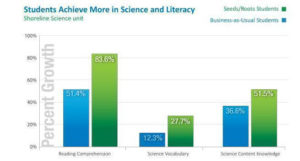Program development
In order to develop Amplify Science as a program designed for three-dimensional instruction while also ensuring that it would be founded on research-proven pedagogy and in-class techniques, the authors at the Lawrence Hall of Science followed a rigorous research and development process, which we describe in the sections below.
Starting with a research-proven approach
The curriculum developers at the Lawrence Hall of Science leveraged their literacy-rich, multimodal learning approach of Do, Talk, Read, Write. This approach, which was used in the Hall’s successful Seeds of Science/ Roots of Reading® program, has been extensively assessed by outside evaluators from the National Center for Research on Evaluation, Standards, and Student Testing (CRESST) at the University of California, Los Angeles, 2005; by Mark Girod at Western Oregon University, 2005; and by David Hanauer at Indiana University of Pennsylvania, 2005. A total of three gold standard studies were conducted on the Seeds of Science/Roots of Reading® approach, in each case using content-comparable, business-as-usual comparison groups. Looking across these three studies at the results of students’ gains in science understanding, students using the Do, Talk, Read, Write approach (i.e. Seeds of Science/Roots of Reading®) consistently outperformed students in the comparison groups on measures of science content knowledge. Some example findings from these evaluations include the following:
Independent Evaluators from the Center for Research on Evaluation, Standards, and Student Testing (CRESST) at University of California, Los Angeles found that second- and third-grade students receiving Do, Talk, Read, Write instruction (via Seeds of Science/Roots of Reading®) significantly outperformed students receiving their usual science instruction in Reading Comprehension, Science Vocabulary, and Science Content Knowledge.
English language learners who experienced Do, Talk, Read, Write instruction (via Seeds of Science/Roots of Reading®) significantly outperformed other English language learners in reading comprehension, science vocabulary, and science content knowledge.

Knowing that Do, Talk, Read, Write was benefiting students, the Lawrence Hall of Science curriculum developers decided to use the approach in their new curriculum, but with the enhancement of adding “Visualize,” which would allow students to learn the practice of modeling and observe scientific phenomena in ways never before possible.
Initial development
With a research-proven approach to science learning established, the authorship team at the Lawrence Hall of Science began an iterative process of outlining, writing, testing, and revising 48 units that would become Amplify Science K–8. In the initial drafts, the Hall considered such facets as what the anchoring phenomena could be; what scientist or engineer role students would assume; how students would go about figuring out the phenomena; and which concepts and practices the unit would target. During the initial development, the authors consulted practicing scientists and incorporated their expert advice into the design of the units. Throughout the process of crafting all of the activities, lessons, and units, the team embraced the following principles, which remain evident in the final curriculum:
- Learning organized around the explanation of real-world phenomena.
- Careful bundling and sequencing of disciplinary core ideas to support deep understanding.
- Meaningful focus on crosscutting concepts (CCCs).
- Thoughtful inclusion and sequencing of science and engineering practices (SEPs).
For more information on how these principles are embedded in the program, please see the “Approach” section.
Pilot testing and revisions
In addition to consulting disciplinary experts as they developed each unit, the Lawrence Hall of Science also worked with students and teachers in and around the San Francisco Bay Area. The developmental pilot tests that the Hall carried out in these classrooms enabled them to collect data and feedback from real teachers and students; to gauge the level of student engagement in the lessons; and to consider lesson length in the context of an actual classroom. Using this valuable information, the team further revised lessons, refining them over time so that they would serve the learning goals and targeted standards of the respective unit, fit within a 45–60 minute class session (depending on the grade), and be authentically three-dimensional and engaging.